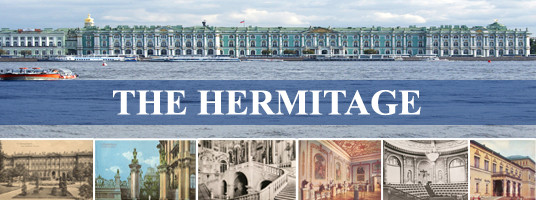State Hermitage Museum

The Hermitage was founded in 1764, when Catherine II acquired a collection of paintings from the Prussian merchant Johann Ernst Gotzkowsky in Berlin. This way the merchant’s debt for the failed supply of grain for the Russian army was settled. The collection of paintings included 317 works of Flemish, Dutch and Italian artists of the first half of the 17th century. These paintings were placed in private apartments of the Winter Palace called Hermitage (from the French ermitage - a place of solitude, a place where a hermit lives, secluded spot). Over time this name was used to refer to the entire museum collection.
Large private collections of paintings – Bruhl’s (1769), Crozat’s (1772), Walpole’s (1779) collections, to name but a few - were purchased abroad to enlarge the Hermitage holdings. By 1774 the catalogue of paintings of the Winter Palace featured 2,080 works. In addition to paintings, acquisitions included collections of engravings and drawings, antiquities, works of Western European decorative and applied art, coins and medals, as well as books (Voltaire's library). In the 19th century, archaeological finds entered the Hermitage holdings and formed the basis of the famous Scythian collection. The Hermitage Museum was expanded with works of Russian painters. Some of them were transferred to the Russian Museum in 1895.
Until mid-19th century the Hermitage was a private museum, which was open to a select few. The art collection became available to the general public under Emperor Nicholas I on February 5 (17), 1852. The New Hermitage was constructed specially to house the collection. Since then the Hermitage has been housed within five interconnected buildings on the Palace Embankment, including the Winter Palace (1754–1762, architect Bartolomeo Rastrelli), the Small Hermitage (1764–1767, architect Jean-Baptiste Vallin de la Mothe), the Old Hermitage (1771–1787, architect Yury Velten), the New Hermitage (1839–1852, architect Leo von Klenze) and the Hermitage Theatre (1783–1787, architect Giacomo Quarenghi).
Today, the Hermitage is one of the world’s largest art, cultural and historical museums. It is home to the richest collections of relics of prehistoric and oriental cultures, cultures of Ancient Egypt, antiquity and the Middle Ages, Western and Eastern European art, archaeological artefacts and relics of Asian art and Russian culture (8th-19th centuries).
The collection, which is built up ahead of the 255th anniversary of the State Hermitage Museum, contains publications dating from the 19th – 20th centuries on the history of the museum and its art collection; archival materials, which spotlight the history of the development of the Hermitage collection throughout the 19th century, the museum staff, balls and masquerades, which were held in the palace, the institution’s publishing activities, the fire of 1837 and the museum’s activities during the revolution of 1917; visual materials (postcards and photographs with views of the Hermitage buildings, its halls and collections); a documentary film about the museum and historical newsreel footage of 1906.






